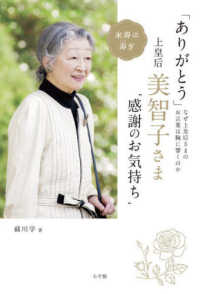- ホーム
- > 洋書
- > 英文書
- > History / World
Full Description
Why is Cleopatra, a descendent of Alexander the Great, a Ptolemy from a Greek-Macedonian family, in popular imagination an Oriental woman? True, she assumed some aspects of pharaonic imagery in order to rule Egypt, but her Orientalism mostly derives from ancient (Roman) and modern stereotypes: both the Orient and the idea of a woman in power are signs, in the Western tradition, of 'otherness' - and in this sense they can easily overlap and interchange.
This volume investigates how ancient women, and particularly powerful women, such as queens and empresses, have been re-imagined in Western (and not only Western) arts; highlights how this re-imagination and re-visualization is, more often than not, the product of Orientalist stereotypes - even when dealing with women who had nothing to do with Eastern regions; and compares these images with examples of Eastern gaze on the same women. Through the chapters in this volume, readers will discover the similarities and differences in the ways in which women in power were and still are described and decried by their opponents.
Contents
List of Figures
List of Contributors
Acknowledgments
1. Introduction Filippo Carlà-Uhink, Potsdam University, Germany & Anja Wieber, Independent Scholar, Germany
2. Semiramide in India. The Reception of an Ancient Oriental Warrior Queen in Baroque Opera Kerstin Droß-Krüpe, Universität Kassel, Germany
3. Carian Queens from the Orient to Greece and Back: The Reception of Artemisia I and Artemisia II Irene Berti, Independent Scholar, Germany
4. The Persian Boy, the Bactrian Girl and the Man from Macedon - Gender and Orientalisms in Mary Renault's Alexander the Great-Trilogy Ann-Cathrin Harders, Universität Bielefeld, Germany
5. Drypetis in Fact and (Fan) Fiction Sabine Müller, Universität Marburg, Germany
6. Exotic, Erotic, Heroic? Women of Carthage in Western Imagination Marta Garia Morcillo, University of Roehampton, UK
7. In the Name of Cleopatra: Emma Hamilton and Catherine Stepney Make Their Mark Mary Hamer, Kipling Society, UK
8. Colon(ial)izing Fulvia: (Re)Presenting the Military Woman in History, Fiction, and Art Peter Keegan, Macquarie University, Australia
9. The Oriental Empresses of Rome. Severan Women in Literature and the Performative Arts Martijn Icks, University of Amsterdam, The Netherlands
10. The Palmyrene Queen Zenobia in Syrian TV - Inverting Orientalism for Modern Nationhood? Anja Wieber, Independent Scholar, Germany
11. The Dark Gaze of Galla Placidia, Christopher Bishop, Australian National University, Australia
12. Theodora A.P. (After Procopius) / Theodora A.S. (After Sardou): Metamorphoses of an Empress Filippo Carlà-Uhink, Potsdam University, Germany
13. From Historical Enigma to Modern Role Model: The Reception of Sasanid Queen Širin in Contemporary Iranian Cinema Irene Madreiter, Universität Innsbruck, Austria
14. Instead of a Conclusion: Gynaecocracy in the Orient, Oriental Seclusion in the Occident Beate Wagner-Hasel, Universität Hannover, Germany
Notes
Bibliography
Index








